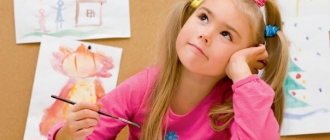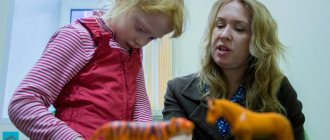In older preschool age, all mental functions and cognitive processes are aimed at improving speech skills. A 6-year-old child has a large vocabulary, answers questions in detail, logically and consistently expresses his desires, experiences, thoughts, and also pronounces all sounds correctly and uses complex sentences. All this is necessary for further education at school.
In the article we will talk about the features of this age, exercises to improve all its components, methods of teaching reading and writing.
Peculiarities of speech development in preschoolers aged 6–7 years
All components of speech - vocabulary, grammatical structure, pronunciation, coherence - reach a new level, because they form the foundation for successful study.
Guys' vocabulary
The first criterion for assessing speech development. Preschoolers know from 4 to 7 thousand words. Of these, they use 70% constantly. Words from the passive dictionary are not used because they do not understand their meaning.
The guys know the names of the days of the week, months, holidays, seasons, cities; quantities up to 100; professions, sports; names, other information about relatives; body parts, colors, shades; natural phenomena; Houseware; plants, animals; can name emotions, feelings.
The grammatical structure of sentences
The second criterion for assessing speech development. The guys speak in full, complex sentences. There are mistakes in their speech, but rarely. They make up new words from others, change them by gender, case, and number. They cope with the formation of complex forms of nouns, verbs, and adjectives.
Children's speech coherence
The third criterion for assessing speech development. Preschoolers speak consistently, coherently, and logically. Conduct a monologue or dialogue. They fantasize a lot and write vivid stories. They can retell the plot of a book or film, or compose a fascinating story based on pictures.
Phonetics: pronunciation of sounds
The fourth criterion for assessing speech development in children 6–7 years old. The children not only pronounce sounds correctly, they can isolate them in the flow of speech and determine their location in a specific word. They select words that begin with a given sound and distinguish words that sound similar (“cancer” - “poppy”). But there are still difficulties in distinguishing paired “w” - “w”, “ts” - “s”, “s” - “w”. They distinguish and control the timbre and volume of the voice, determine the source of noise, and depict the sounds of nature and animals. They can divide words into syllables and distinguish consonants from vowels.
Sufficient development of speech and all its components lays the foundation for further learning to read and write.
Parents' activity in the development of their child's speech
It is important for parents to consider that each child has his own individual pace of development. Noticing problems in the development of speech in their child in the preschool period and some discrepancy with the norms, they should not jealously compare with others and catch up with their peers, at all costs. However, this issue cannot be ignored.
Parental assistance is necessary for a preschooler in cognitive and speech development. Children, with the support of their parents, successfully progress in the following areas:
- vocabulary formation
- word creation
- development of verbal description skills.
In everyday communication with a child, parents have hundreds of opportunities to use new concepts and explain what they mean. Such simple participation of adults will significantly expand the active vocabulary of a preschooler.
Word creation allows the child to better understand the language and contributes to the development of a sense of rhythm. In addition to benefits in speech development, this activity brings incredible pleasure to children. Emotional speech, joint invention of new words with mom or dad is always accompanied by laughter and a joyful mood.
Parents can successfully teach verbal descriptions to their child. An adult can tell stories and describe what is happening to a preschooler, giving an example of a coherent statement, and then invite him to similarly describe what he sees around him. These activities are easy to do and can be done in any environment - at home or on a walk.
Norms of speech development
Here are the standards established for speech development in children 6–7 years old:
- Vocabulary - 4000 - 7000 words. Of these, nouns predominate;
- Can select antonyms and synonyms;
- Speaks in complex, complex sentences;
- A 6-year-old child agrees and combines words according to their meaning;
- Speaks expressively, emotionally, understands, uses interrogative and exclamatory forms;
- Uses conjunctions;
- Speech is coherent, logical, consistent;
- Pronounces all sounds clearly, does not “swallow” the endings of words - articulation is good;
- Understands figurative expressions, such as “sunny smile”;
- Declines according to gender, number, case of a word;
- Highlights the main thing in the story, the secondary can be omitted;
- Retells the plots of books and films - meaningfully, succinctly, logically;
- A 6-year-old child can explain the meaning of a familiar word;
- Forms nouns with suffixes, verbs with prefixes;
- Operates with comparative, superlative degrees of adjectives, composes them (for example, “deep - deeper - deeper - deepest - deepest of all”).
- Understands and can evaluate the emotion he is experiencing;
- Selects the 4th extra.
A 7 year old child can construct sentences of any complexity, writes and reads syllable by syllable.
Speech development in children aged 6–7 years occurs during play. They fully use it as a means of communication with peers and adults. At school, it will become a means of mastering a new type of activity - educational. This is why it is so important to develop skills from early childhood.
Speech development of children in older preschool age
Speech development is a designation of stages and techniques in a complex associated with mastering the means of speech, which are characterized by the development of verbal thinking, communication and creativity skills.
Speech is a dynamic phenomenon. Language does not stand still, but adapts to conditions and realities. Children feel these innovations better than us. The preschool stage is determined by intensive speech development. The children are making a leap in expanding their vocabulary. The speech became concrete and meaningful. At older preschool age, a child’s vocabulary already reaches 3-4 thousand words. During this period, children develop a “sense of language.” The young “linguist” intuitively senses the language norm. The child provides comments on the actions. Says: what am I doing now?
The growing needs of a preschooler act as a motive for language acquisition. The speech regulation function develops, which helps control activity and behavior. All activities are related to speech. The preschooler has new tasks and his social circle among peers and adults expands. It is important for a child to be understood by his interlocutors. The “little man” listens to people’s speech and copies the phrases and phrases he likes.
Observations play a role in vocabulary acquisition. The ability to see and feel the beauty of nature is formed during walks in the fresh air. Let them want to talk about the color of the clouds or the shape of the leaves on the trees! In the process of observation, children's vocabulary expands, and sentences acquire complex structures. .
Speech development disorders and their prevention
Most often in older preschoolers these disorders manifest themselves in incorrect pronunciation. There are several types of violations:
- dyslalia - incorrectly pronounces individual sounds, which is quickly eliminated with the help of a speech therapist;
- dysarthria - articulation and voice formation are impaired, the help of a neurologist is needed;
- rhinolalia - incorrect pronunciation of sounds, the voice is monotonous, slurred, the help of an otolaryngologist is needed;
- motor alalia - children understand everything, but cannot speak coherently, incorrectly agree words by gender, number, case;
- sensory alalia - children do not understand the meaning of words addressed to them, they need the help of a neurologist, psychiatrist, speech therapist-defectologist;
- aphasia - a disorder due to neuroinfection or traumatic brain injury;
- reactive mutism - the child used to speak, but then abruptly stopped due to a neurological disease;
- stuttering - lack of fluency of speech, a 6-year-old child repeats syllables and sounds, speaks intermittently.
Another group is speech delay (SD) against the background of mental disorders (MD).
Prevention of disorders by a speech therapist
To prevent problems in a 7-year-old child, it is necessary to develop him from early childhood: talk to him, show him, name objects, read fairy tales, nursery rhymes, sing songs, develop fine motor skills.
The help of a speech therapist would be helpful. It helps the little patient develop articulatory and fine motor skills; cognitive processes, skills of analyzing what is heard.
What is “connected speech”?
An utterance or coherent speech is several complete segments (sentences) that are connected thematically, in meaning, and in structure. It serves to facilitate communication and is expressed in two forms:
- monologue - the ability to talk about a certain image, action, etc.;
- Dialogue is direct interaction with another person or people through communication.
Statements are the result of perception, comprehension, and the ability to express one’s thoughts. Coherent speech gives a clear understanding of the relationship between a child’s mental and speech development and helps solve problems in all areas of upbringing and education.
Monologue speech of older preschoolers consists of several main types:
- description - includes the general name of the object (action), a listing of its properties, qualities, and in conclusion - an assessment or attitude towards it (parts of this structure can be rearranged);
- narration is a statement of fact in which the beginning of the story, its culmination, outcome or denouement is clearly visible;
- reasoning is a separate type of statement that reflects a certain connection of events, facts, phenomena (consists of a statement, evidence, conclusion).
All these variants of coherent speech are found in children in a mixed form.
The initial and most important stage in the development of coherent speech in children is dialogue. It reveals the specifics of interaction, allows you to convey to the child the norms and rules for the further construction of monologue speech according to the laws of the literary language.
In order to correctly organize work on the formation of coherent speech in preschoolers, it is necessary to know the stages of its development, as well as to identify the main tasks for each type of speech separately.
Speech development of preschoolers 6 – 7 years old: improving coherence
Use every opportunity to improve the quality of your son or daughter’s speech.
Create a favorable environment around your child. Children learn their native speech by ear, so you must speak correctly and competently. Remember: you are a model for your daughter or son, and he will imitate you.
Teach your child to art - literature, theater. A good way is to learn rhymes and songs. Read good books together, listen to plays in audio format, go to the theater. Don’t forget to discuss what you saw and read. You will be surprised how quickly your baby’s speech will become more meaningful, richer, and more varied.
Here are some more simple exercises.
Dreamers. Give your child a topic and let him come up with a story (for example, “When I grow up...”, “If I had a magic wand...”).
Wimmelbook story. Buy your child a colorful book with pictures and no words. Let him make up stories about the characters.
We write, we draw. Come up with a story together, write it down, draw pictures for it.
To improve the speech of a 7-year-old child, you don’t have to take him to developmental classes - you can study at home, because it’s so interesting!
A set of games for speech development for 6 – 7 years old
“What does the word mean?” The parent names the objects, the child groups them: for example, table - furniture, plate - dishes.
"What is a name?" They ask you to name your name, mom, dad, friends.
"Who's doing what?". The adult invites the child to look around and say who can sleep, sit, walk, and what can ride and sound.
“Say the word.” The parent calls the sound to the baby, and he says the words that begin with it. Then, using the same analogy, names.
"Count the syllables." The adult names the words, and the preschooler’s task is to count how many syllables are in each of them.
“We swim, we fly, we go.” A parent shows his son or daughter pictures of transport. The task is to say what each of them is doing (the plane is flying, the bus is driving).
"Solve the puzzle." Mom suggests any topic (transport, fruit), thinks of a word, says the first and last letter. He must guess what word the adult said.
“Tell me.” The parent asks the child to tell about his favorite fruit so that the adult can guess it.
Adults can come up with such games for speech development for 6-7 year olds on their own.
Reasons for the delay in the formation of coherent speech in children
To determine the level of development of coherent speech, you need to analyze compliance with the age criteria listed above, that is, make a kind of diagnosis. It should be carried out in a playful way, without focusing the child’s attention on the result, without making comments, without correcting, without teaching. Just create a situation and observe the behavior and speech of a preschooler.
Difficulties and difficulties in speech development can occur in children for medical reasons:
- pathology of intrauterine development (mother's exposure to infectious diseases, intense toxicosis);
- birth injuries (asphyxia, premature birth, infection, etc.);
- childhood head trauma, especially in the area of speech zones;
- hearing or speech impairment (the latter is diagnosed by age 5).
There are also social reasons that slow down the development of coherent speech in a child:
- pedagogical neglect - they do not work with the child or the child exhibits behavioral disorders (“difficult child”);
- lack of communication in a family - the lack of direct, close communication between all its members, when several people simply exist under one roof;
- change of place of residence, especially in a foreign-language environment - if at home they speak one language, in a child care center and on the street - in another, the child experiences difficulties in mastering speech skills.
Excessive care can also lead to speech delays, since the child simply does not need to speak if his wishes are guessed and instantly fulfilled.
As a rule, by the age of 5-6 years a child can:
- consistently answer questions;
- compose short narratives based on illustrations;
- describe your impressions of what you saw;
- convey the content of what was heard or seen from memory;
- come up with a continuation of a fairy tale, fantasize.
But in order for the result to meet age requirements, it is necessary to pay enough attention to communication and activities with the child at each stage of growing up.
Learning to write and read
Moms and dads strive for their child to learn to read and write as early as possible. But psychologists and neurologists do not recommend doing this. Firstly, the child must master new skills in a timely manner (and earlier does not always mean better), and secondly, children need to be taught using a special method. It is owned by kindergarten teachers and primary school teachers, but parents can make many mistakes and only harm their child.
Instead, focus on preparing to master new skills.
Learn sounds. Moms and dads often teach their children letters, but this is wrong. Words are built not on letters, but on sounds.
Train your articulation apparatus. This is the key to correct pronunciation.
Learn to write in block letters, not in capital letters. Schools use the continuous writing method. Other techniques will only do harm; the student will have to relearn, and this is much more difficult.
Get your little hand ready to write. Let him draw, cut out, hatch, paint, put together a mosaic, draw dots on checkered paper - this trains fine motor skills, muscles, and develops spatial orientation.
Let's talk separately about the sound-letter analysis of words. This is where preschoolers begin to be taught to read.
Learn to read step by step
Stage one - learning sounds.
- Start by learning a group of sounds. Use a primer or alphabet - learn in the same sequence.
- Tell us about vowels and consonants. How to pronounce them (drawn out, abruptly), how they differ.
- Tell us about syllables. Show how you can make a syllable from two sounds. Talk about the difference between letters (they are written) and sounds (they are pronounced). Show examples, for example “ma”, “sha”, “ra”, “ma”.
- It is correct to teach your child: “b”, “p”, “v”, and not the letters “be”, “pe”, “ve”. Otherwise, the daughter or son will read letter by letter: “Me - a - sha - a”, place “Ma-sha”. It will be more difficult and longer for him to learn to read by syllables, then by words. Complex words will even look like puzzles: “a - ve - te - o - be - y - es” instead of “av-to-bus” is much more difficult to perceive.
Stage two - read:
- We learn to combine sounds into syllables. Task for the baby: pronounce the first sound in the word until he reads the second: “m-m-m-m-a-a”;
- Finding syllables in a word. Assignment: ask your son or daughter to find certain combinations of letters in a word. Let him read them;
- We make up new words. Ask your child to make up a few words from familiar syllables and read them;
- Adding sounds. The baby adds one sound to familiar syllables, reads, composes new syllables, words;
- Learning to read closed syllables. First, show the difference between an open (“ka”) and a closed (“an”) syllable.
If the preschooler has completed these stages successfully, you can complicate the task - move on to more complex words, and then to sentences.
Pay attention to the fact that the child puts the emphasis correctly and understands the meaning of the words read. If he doesn’t understand, explain. Practice in the form of a game.
Article:
Analysis of preschool education and development programs allows us to determine the existing requirements for the development of speech of children of senior preschool age: correctly perceive and understand statements or messages addressed to children, differentiate and correctly pronounce phonemes, intonation, stress, separation using speech pauses, speak clearly;
have sufficient vocabulary and grammatically correct speech; the ability to interact with another person; retell and discuss what you heard and saw; express your point of view. At the same time, in the 80-90s of the twentieth century, new approaches to understanding the essence of speech development in older preschoolers and younger schoolchildren were determined - from the position of the theory of speech activity (works by A.A. Leontyev, I.A. Zimnyaya, N.I. Zhinkin , T.A. Ladyzhenskaya, N.A. Plenkina, V.I. Kapinos, A.Yu. Kupalova, M.R. Lvova, M.S. Soloveichik). First, psychologists, then teachers, came to the conclusion that speech is also a unique human activity, and the very content of this activity, its features, began to be defined based on the concepts of “speech” and “language”.
Speech development involves teaching children speech, which is possible only in the conditions of organized educational speech activity.
Speech activity is considered by us as a communicative process that is carried out during communication, and therefore presupposes the presence of partners, i.e. the one who creates speech (speaks, writes), and the one who receives it (listens, reads).
“Speech activity... is a process of active, purposeful, language-mediated and situation-conditioned communication of receiving or issuing a speech message in the interaction of people with each other (with each other).” [1]
Children enter into certain relationships with other people, and therefore they need to understand the speech statements of others as accurately as possible, and be able to correctly express their impressions, experiences, intentions and thoughts in speech; possess verbal communication skills, have a sufficient level of speech (verbal) thinking.
A child’s mastery of his native language in the process of pedagogically organized speech development, limited by the needs of the child’s communication with the people around him, does not correspond to the child’s potential capabilities either in mastering linguistic reality as a special object of cognition, or in the development and improvement of speech itself.
The child’s entry into such educational and cognitive activities, in accordance with the theory of A.N. Leontiev, is ensured by the very structure of the activity: “Every activity has a ring structure: initial afferentation – effector processes that implement contacts with the objective environment – correction and enrichment with the help of feedback of the initial afferent image.” [3]
Like any other activity, speech activity has an object (thought) and structure. “In any activity, the same structural components can be identified. It has four stages: a) the stage of orientation in the conditions of activity; b) the stage of developing a plan in accordance with the results of the orientation; c) stage of implementation (implementation) of this plan; d) control stage.” [3]
Let's consider a schematic representation of the structure of any human activity, proposed by A.N. Leontyev:
where a need is understood as an experienced need, a motive as an incentive to activity, a goal as a consciously projected image, an action as a unit of activity, a task as a goal of activity given in certain conditions, an operation as a way of carrying out an action.
Let’s correlate these concepts with the content of speech activity:
Subject – thought (expressed or perceived).
Need – desire for communication (communicative need).
Motive is an opportunity through communication (with a person, a book, etc.) to understand, learn, communicate, express, prove, etc. (cognitive interest, personal motive).
The goal is the projected result (the interlocutor’s reaction, finding an answer, knowing the information, understanding the text, etc.).
Action - speaking, reading, writing, listening, when language is used as a means of speech activity.
A task is a product of activity (sentence, text, conclusion, etc.).
Operation – a method of action (selection of content for expression, use of linguistic means to express this content, etc.).
The concept of types of speech activity belongs to the famous linguist and teacher L.V. Shcherbe and is considered by us both methodological and psychological. Usually there are four main types of speech activity: reading, listening (listening) - receptive types of speech activity; oral speech (speaking) and writing, which are called productive types.
The concept of types of speech activity in the methodology allows you to more clearly imagine the psychological patterns of the formation of relevant skills and abilities: methodological techniques, types of exercises, etc. must be correlated with the structure and formation of corresponding psychological mechanisms, always complex and multi-level.
This means that in practice, the need to ensure the formation of individual psychological operations and their complexes cannot but take into account the fact of the interaction of different types of speech activity , their mutual intertwining, especially when solving complex communication problems. It is hardly correct to deal completely separately and incoherently with preschoolers with reading, listening, and oral speech. It is better to build classes with preschoolers as integrated from the very beginning. [2]
The statement of L.S. is widely known. Vygotsky: “It is not thinking that thinks, it is man who thinks,” which can be continued: the hand does not write, the tongue does not speak, the ear does not listen. It is especially important to take this into account in relation to teaching reading.
Let us note that the process of learning to read at the preschool stage is traditionally perceived as teaching a child to reproduce a printed word (text) aloud, and it is precisely at what age such learning can begin that, as a rule, there is debate. Reading as a type of speech activity is practically not considered in relation to preschoolers. The main research is related to the methodology of teaching children 3-6 years old to speak (oral coherent speech) in a sensitive period for this.
In addition, for some reason it is generally accepted that by teaching a child to read aloud, we ensure his ability to read in general. However, according to A.A. Leontyev, “learning to read aloud is not so much learning to read as learning oral speech and the development of the articulatory apparatus.” [3] Fully sharing the position of the scientist, we also note that in the process of listening to what adults read to preschoolers, the reader-listener engages three of the four spheres of the reader’s perception of the text: the emotional sphere, the sphere of imagination and reaction to the content of the text. Our research confirmed the initial assumption that readers aged 5-7 years practically do not involve the sphere of reaction to artistic form in the reading process.
Thus, the nature of older preschoolers’ perception of the text, which, as a rule, is read to them by an adult, suggests that children are more likely to be involved not so much in the listening process as in the reading process. The type of speech activity when the text is perceived by ear, and at the same time the inclusion of emotions, imagination and reaction to the content of what is read is ensured, we call reading-listening.
Of course, children need to be taught reading and listening, and we consider the age of an older preschooler as an extremely sensitive period for solving this problem. The child, most likely, will not be able to do what we did not specifically teach him. Many troubles in the future study of the school literature course are rooted precisely in the fact that we did not teach older preschoolers to read (perceive) a literary text as fiction.
In general, full-fledged training in various types of speech activity at the stage of preschool education is a condition for the successful future educational activity of a schoolchild and at the same time “it is a tool for his self-development, something that makes possible his self-education, socialization, his further cognitive, personal, artistic and value development.” [2]
Ways to improve the speech activity of older preschoolers and younger schoolchildren were suggested by M.S. Soloveitchik:
- broadening their horizons, ensuring the renewal of children’s thoughts and feelings, potential subjects of their speech activity;
- children’s awareness of the language system, the purpose of various language units;
- developing the ability to choose language means taking into account the communication situation and correctly formulate one’s thoughts;
- developing the ability to select content for expression and organize it in accordance with the plan;
- understanding the significance of all elements of a “foreign” text, developing the ability to extract meaning from each element of the text.
So, today, preschool specialists are faced with the task of ensuring the full speech development of preschool children, revealing rather complex phenomena of a new language reality for them, cultivating interest in language and thereby increasing activity in its acquisition.
Based on the above, we can outline the main content of the work that ensures the development of speech activity of older preschoolers:
Literature: 1. Zimnyaya, I.A. Psychology of teaching a non-native language. / I.A. Winter. – M, 1989. – P. 133. 2. Leontiev, A.A. Language and speech activity in general and educational psychology: Selected articles. psychol. works / A.A. Leontyev. – M.: Publishing house of the Moscow Psychological and Social Institute; Voronezh: Publishing house NPO "MODEK", 2003. – 536 pp. 3. Leontyev, A.N. Consciousness, activity, personality./ A.N. Leontyev. – M.: Politizdat, 1977. – P.86.







